
- •Contents
- •Preface
- •Chapter 1 Introduction (K. Fujimoto)
- •Chapter 2 Small antennas (K. Fujimoto)
- •Chapter 3 Properties of small antennas (K. Fujimoto and Y. Kim)
- •Chapter 4 Fundamental limitation of small antennas (K. Fujimoto)
- •Chapter 5 Subjects related with small antennas (K. Fujimoto)
- •Chapter 6 Principles and techniques for making antennas small (H. Morishita and K. Fujimoto)
- •Chapter 7 Design and practice of small antennas I (K. Fujimoto)
- •Chapter 8 Design and practice of small antennas II (K. Fujimoto)
- •Chapter 9 Evaluation of small antenna performance (H. Morishita)
- •Chapter 10 Electromagnetic simulation (H. Morishita and Y. Kim)
- •Chapter 11 Glossary (K. Fujimoto and N. T. Hung)
- •Acknowledgements
- •1 Introduction
- •2 Small antennas
- •3 Properties of small antennas
- •3.1 Performance of small antennas
- •3.1.1 Input impedance
- •3.1.4 Gain
- •3.2 Importance of impedance matching in small antennas
- •3.3 Problems of environmental effect in small antennas
- •4 Fundamental limitations of small antennas
- •4.1 Fundamental limitations
- •4.2 Brief review of some typical work on small antennas
- •5 Subjects related with small antennas
- •5.1 Major subjects and topics
- •5.1.1 Investigation of fundamentals of small antennas
- •5.1.2 Realization of small antennas
- •5.2 Practical design problems
- •5.3 General topics
- •6 Principles and techniques for making antennas small
- •6.1 Principles for making antennas small
- •6.2 Techniques and methods for producing ESA
- •6.2.1 Lowering the antenna resonance frequency
- •6.2.1.1 SW structure
- •6.2.1.1.1 Periodic structures
- •6.2.1.1.3 Material loading on an antenna structure
- •6.2.2 Full use of volume/space circumscribing antenna
- •6.2.3 Arrangement of current distributions uniformly
- •6.2.4 Increase of radiation modes
- •6.2.4.2 Use of conjugate structure
- •6.2.4.3 Compose with different types of antennas
- •6.2.5 Applications of metamaterials to make antennas small
- •6.2.5.1 Application of SNG to small antennas
- •6.2.5.1.1 Matching in space
- •6.2.5.1.2 Matching at the load terminals
- •6.2.5.2 DNG applications
- •6.3 Techniques and methods to produce FSA
- •6.3.1 FSA composed by integration of components
- •6.3.2 FSA composed by integration of functions
- •6.3.3 FSA of composite structure
- •6.4 Techniques and methods for producing PCSA
- •6.4.2 PCSA employing a high impedance surface
- •6.5 Techniques and methods for making PSA
- •6.5.2 Simple PSA
- •6.6 Optimization techniques
- •6.6.1 Genetic algorithm
- •6.6.2 Particle swarm optimization
- •6.6.3 Topology optimization
- •6.6.4 Volumetric material optimization
- •6.6.5 Practice of optimization
- •6.6.5.1 Outline of particle swarm optimization
- •6.6.5.2 PSO application method and result
- •7 Design and practice of small antennas I
- •7.1 Design and practice
- •7.2 Design and practice of ESA
- •7.2.1 Lowering the resonance frequency
- •7.2.1.1 Use of slow wave structure
- •7.2.1.1.1 Periodic structure
- •7.2.1.1.1.1 Meander line antennas (MLA)
- •7.2.1.1.1.1.1 Dipole-type meander line antenna
- •7.2.1.1.1.1.2 Monopole-type meander line antenna
- •7.2.1.1.1.1.3 Folded-type meander line antenna
- •7.2.1.1.1.1.4 Meander line antenna mounted on a rectangular conducting box
- •7.2.1.1.1.1.5 Small meander line antennas of less than 0.1 wavelength [13]
- •7.2.1.1.1.1.6 MLAs of length L = 0.05 λ [13, 14]
- •7.2.1.1.1.2 Zigzag antennas
- •7.2.1.1.1.3 Normal mode helical antennas (NMHA)
- •7.2.1.1.1.4 Discussions on small NMHA and meander line antennas pertaining to the antenna performances
- •7.2.1.2 Extension of current path
- •7.2.2 Full use of volume/space
- •7.2.2.1.1 Meander line
- •7.2.2.1.4 Spiral antennas
- •7.2.2.1.4.1 Equiangular spiral antenna
- •7.2.2.1.4.2 Archimedean spiral antenna
- •7.2.2.1.4.3.2 Gain
- •7.2.2.1.4.4 Radiation patterns
- •7.2.2.1.4.5 Unidirectional pattern
- •7.2.2.1.4.6 Miniaturization of spiral antenna
- •7.2.2.1.4.6.1 Slot spiral antenna
- •7.2.2.1.4.6.2 Spiral antenna loaded with capacitance
- •7.2.2.1.4.6.3 Archimedean spiral antennas
- •7.2.2.1.4.6.4 Spiral antenna loaded with inductance
- •7.2.2.2 Three-dimensional (3D) structure
- •7.2.2.2.1 Koch trees
- •7.2.2.2.2 3D spiral antenna
- •7.2.2.2.3 Spherical helix
- •7.2.2.2.3.1 Folded semi-spherical monopole antennas
- •7.2.2.2.3.2 Spherical dipole antenna
- •7.2.2.2.3.3 Spherical wire antenna
- •7.2.2.2.3.4 Spherical magnetic (TE mode) dipoles
- •7.2.2.2.3.5 Hemispherical helical antenna
- •7.2.3 Uniform current distribution
- •7.2.3.1 Loading techniques
- •7.2.3.1.1 Monopole with top loading
- •7.2.3.1.2 Cross-T-wire top-loaded monopole with four open sleeves
- •7.2.3.1.3 Slot loaded with spiral
- •7.2.4 Increase of excitation mode
- •7.2.4.1.1 L-shaped quasi-self-complementary antenna
- •7.2.4.1.2 H-shaped quasi-self-complementary antenna
- •7.2.4.1.3 A half-circular disk quasi-self-complementary antenna
- •7.2.4.1.4 Sinuous spiral antenna
- •7.2.4.2 Conjugate structure
- •7.2.4.2.1 Electrically small complementary paired antenna
- •7.2.4.2.2 A combined electric-magnetic type antenna
- •7.2.4.3 Composite structure
- •7.2.4.3.1 Slot-monopole hybrid antenna
- •7.2.4.3.2 Spiral-slots loaded with inductive element
- •7.2.5 Applications of metamaterials
- •7.2.5.1 Applications of SNG (Single Negative) materials
- •7.2.5.1.1.2 Elliptical patch antenna
- •7.2.5.1.1.3 Small loop loaded with CLL
- •7.2.5.1.2 Epsilon-Negative Metamaterials (ENG MM)
- •7.2.5.2 Applications of DNG (Double Negative Materials)
- •7.2.5.2.1 Leaky wave antenna [116]
- •7.2.5.2.3 NRI (Negative Refractive Index) TL MM antennas
- •7.2.6 Active circuit applications to impedance matching
- •7.2.6.1 Antenna matching in transmitter/receiver
- •7.2.6.2 Monopole antenna
- •7.2.6.3 Loop and planar antenna
- •7.2.6.4 Microstrip antenna
- •8 Design and practice of small antennas II
- •8.1 FSA (Functionally Small Antennas)
- •8.1.1 Introduction
- •8.1.2 Integration technique
- •8.1.2.1 Enhancement/improvement of antenna performances
- •8.1.2.1.1 Bandwidth enhancement and multiband operation
- •8.1.2.1.1.1.1 E-shaped microstrip antenna
- •8.1.2.1.1.1.2 -shaped microstrip antenna
- •8.1.2.1.1.1.3 H-shaped microstrip antenna
- •8.1.2.1.1.1.4 S-shaped-slot patch antenna
- •8.1.2.1.1.2.1 Microstrip slot antennas
- •8.1.2.1.1.2.2.2 Rectangular patch with square slot
- •8.1.2.1.2.1.1 A printed λ/8 PIFA operating at penta-band
- •8.1.2.1.2.1.2 Bent-monopole penta-band antenna
- •8.1.2.1.2.1.3 Loop antenna with a U-shaped tuning element for hepta-band operation
- •8.1.2.1.2.1.4 Planar printed strip monopole for eight-band operation
- •8.1.2.1.2.2.2 Folded loop antenna
- •8.1.2.1.2.3.2 Monopole UWB antennas
- •8.1.2.1.2.3.2.1 Binomial-curved patch antenna
- •8.1.2.1.2.3.2.2 Spline-shaped antenna
- •8.1.2.1.2.3.3 UWB antennas with slot/slit embedded on the patch surface
- •8.1.2.1.2.3.3.1 A beveled square monopole patch with U-slot
- •8.1.2.1.2.3.3.2 Circular/Elliptical slot UWB antennas
- •8.1.2.1.2.3.3.3 A rectangular monopole patch with a notch and a strip
- •8.1.2.1.2.3.4.1 Pentagon-shape microstrip slot antenna
- •8.1.2.1.2.3.4.2 Sectorial loop antenna (SLA)
- •8.1.3 Integration of functions into antenna
- •8.2 Design and practice of PCSA (Physically Constrained Small Antennas)
- •8.2.2 Application of HIS (High Impedance Surface)
- •8.2.3 Applications of EBG (Electromagnetic Band Gap)
- •8.2.3.1 Miniaturization
- •8.2.3.2 Enhancement of gain
- •8.2.3.3 Enhancement of bandwidth
- •8.2.3.4 Reduction of mutual coupling
- •8.2.4 Application of DGS (Defected Ground Surface)
- •8.2.4.2 Multiband circular disk monopole patch antenna
- •8.2.5 Application of DBE (Degenerated Band Edge) structure
- •8.3 Design and practice of PSA (Physically Small Antennas)
- •8.3.1 Small antennas for radio watch/clock systems
- •8.3.2 Small antennas for RFID
- •8.3.2.1 Dipole and monopole types
- •8.3.2.3 Slot type antennas
- •8.3.2.4 Loop antenna
- •Appendix I
- •Appendix II
- •References
- •9 Evaluation of small antenna performance
- •9.1 General
- •9.2 Practical method of measurement
- •9.2.1 Measurement by using a coaxial cable
- •9.2.2 Method of measurement by using small oscillator
- •9.2.3 Method of measurement by using optical system
- •9.3 Practice of measurement
- •9.3.1 Input impedance and bandwidth
- •9.3.2 Radiation patterns and gain
- •10 Electromagnetic simulation
- •10.1 Concept of electromagnetic simulation
- •10.2 Typical electromagnetic simulators for small antennas
- •10.3 Example (balanced antennas for mobile handsets)
- •10.3.2 Antenna structure
- •10.3.3 Analytical results
- •10.3.4 Simulation for characteristics of a folded loop antenna in the vicinity of human head and hand
- •10.3.4.1 Structure of human head and hand
- •10.3.4.2 Analytical results
- •11 Glossary
- •11.1 Catalog of small antennas
- •11.2 List of small antennas
- •Index

184 |
Design and practice of small antennas I |
|
|
Table 7.16 Geometry of antennas ([72], copyright C 2003 IEEE) (inserted in the text)
|
One-arm |
Two-arm |
Four-arm |
|
|
|
|
L (cm) |
8.22 |
8.25 |
8.36 |
a (cm) |
4.15 |
4.15 |
4.18 |
Lw (cm) |
58.23 |
62.8 |
65.53 |
|
|
|
|
Table 7.17 Comparison of resonance properties of antennas ([72], copyright C 2003 IEEE)
Antenna |
fr (MHz) |
Rr (ohms) |
Q |
r/λ |
|
Straight-Wire Dipole |
300 |
1.1 |
– j1015 |
950 |
0.0268 |
Normal Mode Helix |
299.6 |
4.6 |
|
216.6 |
0.0438 |
Spherical Helix |
300.2 |
2.2 |
|
143.9 |
0.0501 |
2-Arm Folded Spherical Helix |
299.6 |
10.3 |
|
101.1 |
.564 |
4-Arm Folded Spherical Helix |
299.9 |
47.5 |
|
87.3 |
0.0592 |
|
|
|
|
|
|
* The small straight-wire dipole is not resonant near 300 MHz. Its performance at 300 MHz is presented for a relative comparison.
of the antenna. Here r is given by [30]
r = (λ/2π )(9/2Q)1/3.
The lower bound Qlb of an electric or magnetic dipole antenna is determined by using [32]
Qlb = η[(ka)−3 + (ka)−1] |
(7.67) |
where η is the radiation efficiency. Then Qlb is calculated to be 57.3 at ka = 0.263. Since Q of the four-arm spherical helix dipole is 87.3, it is about 1.52 times the lower bound on Q for an electric dipole of ka = 0.263.
Radiation efficiency of the four-arm spherical folded dipole is 97.4%.
7.2.2.2.3.3 Spherical wire antenna
An antenna similar to a folded loop mounted on a sphere is introduced as a space-filling small antenna having the performance approaching the fundamental limitation. The antenna is composed of four arms which are arranged in a perpendicular geometry as shown in Figure 7.152, which illustrates (a) the antenna element along with the current flow and (b) a fabricated antenna [75]. With the perpendicular arrangement, radiators do not affect each other so that the cancellation between radiating arms is reduced, and also the scheme is effective to reduce the antenna size and at the same time lower the Q. Due to the orthogonal direction in the current flow as shown in Figure 7.152(a), coupling between antenna arms is minimized. The first vertical arm is on the diameter of a sphere, and has the feeding gap at the center. The second vertical arm, which is a 90◦ arc consists of a quarter of a circle on the sphere vertically. The third element is an arc which is
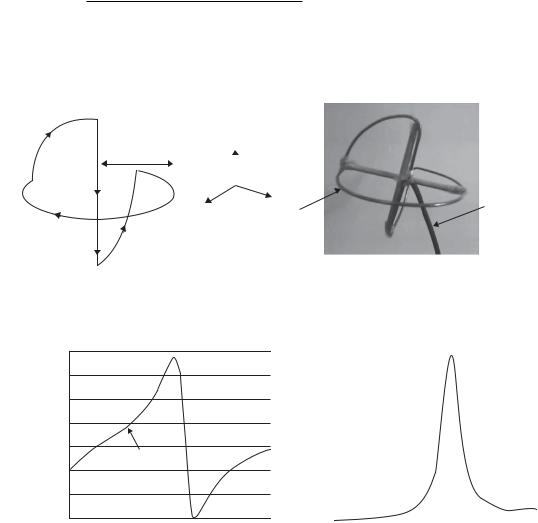
7.2 Design and practice of ESA |
185 |
|
|
Table 7.18 Measured and simulated results of
SWA ([75], copyright C 2009 IEEE)
Results |
f0(MHz) |
Rrad( ) Q |
|
Measurement |
374.6 |
56.62 |
9.48 |
Simulation |
372.45 |
45.15 |
12.14 |
|
|
|
|
(a) 600
|
400 |
|
(Ω) |
200 |
|
0 |
||
Reactance |
||
–200 |
||
|
||
|
–400 |
|
|
–600 |
|
|
–800 |
|
|
250 |
|
|
|
|
|
r0 |
|
|
|
|
|
|
y |
|
|
|
|
|
|
|
|
|
|
|
|
|
|
|
|
|
|
|
|||
|
|
|
|
|
|
|
|
|
z |
|
|
|
x |
|
|
|
|
|
|
|
|
|
|
|
Coaxial cable |
|||||||||
|
|
|
|
|
|
|
|
|
|
|
|
|
|
|
|
|
|
|
|
|
|
|
||||||||||||
|
|
|
|
|
|
|
|
|
|
|
|
|
|
|
|
|
|
|
|
|
|
|
|
|
||||||||||
|
|
|
|
|
|
|
|
|
|
|
|
|
|
|
|
|
|
|
|
|
|
|
|
|
||||||||||
|
|
|
|
|
|
|
|
|
|
|
|
|
|
|
|
|
|
|
|
|
|
|
|
|
|
|
|
|
|
|
||||
|
|
|
|
|
|
|
|
|
|
|
|
|
|
|
Wire |
|
|
|
|
|
|
|
|
|
|
|
|
|
|
|
|
|
||
|
|
|
|
|
|
|
|
|
|
|
|
|
|
|
|
|
|
|
|
|
|
|
|
|
|
|
|
|
|
|
|
|
|
|
|
|
|
|
|
|
(a) |
|
|
|
|
|
|
|
|
|
|
|
|
|
|
|
|
(b) |
|
|
|
|
|
|
|
|
|
|
|
Figure 7.152 Folded spherical wire antenna (SWA): (a) simulated antenna and (b) fabricated |
|
|
||||||||||||||||||||||||||||||||
antenna ([75], copyright C 2009 IEEE). |
|
|
|
|
|
|
|
|
|
|
|
|
|
|
|
|
|
|||||||||||||||||
|
|
|
|
|
|
|
|
|
|
|
|
|
|
|
|
|
(b) |
1400 |
|
|
|
|
|
|
|
|
|
|
|
|
|
|
|
|
|
|
|
|
|
|
|
|
|
|
|
|
|
|
|
|
|
|
|
|
|
|
|
|
|
|
|
|
|
|
|
|
|
||
|
|
|
|
|
|
|
|
|
|
|
|
|
|
|
|
|
|
1200 |
|
|
|
|
|
|
|
|
|
|
|
|
|
|
|
|
|
|
|
|
|
|
|
|
|
|
|
|
|
|
|
|
|
|
|
|
|
|
|
|
|
|
|
|
|
|
|
|
|
|
|
|
|
|
|
|
|
|
|
|
|
|
|
|
|
|
|
|
(Ω) |
1000 |
|
|
|
|
|
|
|
|
|
|
|
|
|
|
|
|
|
|
|
|
|
|
|
|
|
|
|
|
|
|
|
|
|
|
|
|
|
|
|
|
|
|
|
|
|
|
|
|
|
||
|
|
|
|
|
|
|
|
|
|
|
|
|
|
|
|
|
|
|
|
|
|
|
|
|
|
|
|
|
|
|
|
|
|
|
|
|
|
|
|
|
|
|
|
|
|
|
|
|
|
|
|
Resistance |
800 |
|
|
|
|
|
|
|
|
|
|
|
|
|
|
|
|
|
|
|
|
|
|
|
|
|
|
|
|
|
|
|
|
|
|
|
|
|
|
|
|
|
|
|
|
|
|
|
|
|
||
|
|
|
|
|
|
|
|
|
|
|
|
|
|
|
|
|
600 |
|
|
|
|
|
|
|
|
|
|
|
|
|
|
|
|
|
|
f0 |
|
= 372.45 MHz |
|
|
|
|
|
|
|
|
|
|
|
|
|
|
|
|
|
|
|
|
|
|
|
|
|
||||||
|
|
|
|
|
|
|
|
|
|
|
|
|
|
|
|
|
|
|
|
|
|
|
|
|
|
|
|
|||||||
|
|
|
|
|
|
|
|
|
|
|
|
|
|
|
400 |
|
|
|
|
|
|
|
|
|
|
|
|
|
|
|
|
|||
|
|
|
|
|
|
|
|
|
|
|
|
|
|
|
|
|
|
|
|
|
|
|
|
|
|
|
|
|
|
|
|
|
|
|
|
|
|
|
|
|
|
|
|
|
|
|
|
|
|
|
|
|
|
|
|
|
|
|
|
|
|
|
|
|
|
|
|
|
|
|
|
|
|
|
|
|
|
|
|
|
|
|
|
|
|
|
|
200 |
|
|
|
|
|
|
|
|
|
|
|
|
|
|
|
|
|
|
|
|
|
|
|
|
|
|
|
|
|
|
|
|
|
|
|
|
|
|
|
|
|
|
|
|
|
|
|
|
|
|
|
|
|
|
|
|
|
|
|
|
|
|
|
|
|
|
|
|
|
0 |
|
|
|
|
|
|
|
|
|
|
|
|
|
|
|
|
|
|
|
|
|
|
|
|
|
|
|
|
|
|
|
|
|
|
|
|
|
|
|
|
|
|
|
|
|
|
|
|
|||
300 |
350 |
400 |
450 |
500 |
550 |
600 |
650 |
|
|
350 |
400 |
450 |
500 |
550 |
600 |
650 |
||||||||||||||||||
300 |
||||||||||||||||||||||||||||||||||
|
|
|
|
Frequency (MHz) |
|
|
|
|
|
|
|
|
|
Frequency (MHz) |
|
|
|
|
||||||||||||||||
Figure 7.153 Impedance of SWA: (a) resistance and (b) reactance([75], copyright C 2009 IEEE).
three quarters of a circle on the sphere horizontally. The fourth element is similar to the second arm and terminated at the end of the first arm. The sphere has diameter 2r0 = 16 cm, the total wire length is 78.79 cm, and the wire radius is 1 mm. The simulated impedance is shown in Figure 7.153, where (a) gives reactance and (b) is resistance. From the figure, the resonance frequency is observed to be 372.45 MHz. Table 7.18 gives comparison between simulated and measured results. The Q is low enough to compare to the fundamental limitation as the antenna size is as small as kr0 = 0.5. Radiation
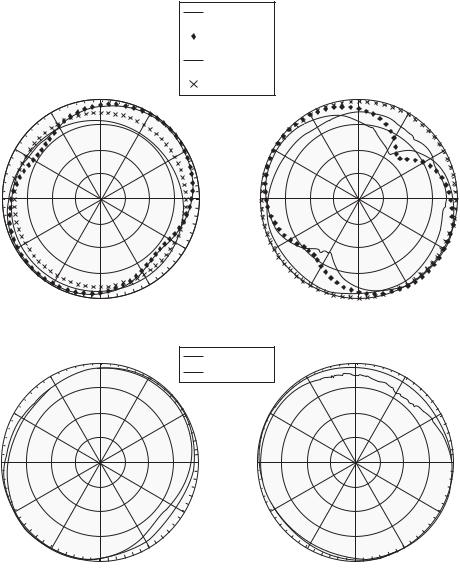
186 |
Design and practice of small antennas I |
|
|
|
|
|
Measured Eθ |
|
|
|
|
|
|
Simulated Eθ |
|
|
|
|
|
|
Measured Eφ |
|
|
|
|
θ = 0° 0 |
|
Simulated Eφ |
θ = 0°0 |
|
|
|
−30° |
|
|
−30° |
||
|
30° |
|
|
30° |
||
|
−10 |
|
|
|
−10 |
|
60° |
−20 |
|
−60° |
60° |
−20 |
−60° |
|
−30 |
|
|
|
−30 |
|
90° |
|
|
−90° |
90° |
|
−90° |
120° |
|
|
−120° |
120° |
|
−120° |
|
150° |
−150° |
|
|
150° |
−150° |
|
180° |
|
|
|
180° |
|
|
(a) |
|
|
|
(b) |
|
|
θ = 0°0 |
−30° |
Measured |E| |
θ = 0° 0 |
−30° |
|
|
30° |
Simulated |E| |
30° |
|||
|
−10 |
|
|
|
−10 |
|
60° |
−20 |
|
−60° |
60° |
−20 |
−60° |
|
−30 |
|
|
|
−30 |
|
90° |
|
|
−90° |
90° |
|
−90° |
120° |
|
|
−120° |
120° |
|
−120° |
|
150° |
−150° |
|
|
150° |
−150° |
|
180° |
|
|
|
180° |
|
|
(c) |
|
|
|
(d) |
|
Figure 7.154 Radiation patterns of SWA (a) x–z plane (Eθ and Eϕ ), (b) y–z plane (Eθ and Eϕ ), x–z plane (|E|) and (d) y–z plane (|E|) ([75], copyright C 2009 IEEE).
patterns are illustrated in Figure 7.154, in which (a) and (b) show Eθ and Eϕ patterns on the x–z plane and y–z plane, respectively, and (c) and (d) show |E| patterns on x–z plane and y–z plane, respectively. They show almost isotropic patterns due to combined radiation from four arms in three directions which distribute energy in all directions and radiation of both horizontal and vertical polarizations for most directions.
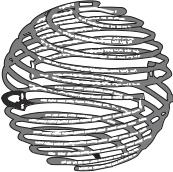
7.2 Design and practice of ESA |
187 |
|
|
Figure 7.155 Multi-turn folded spherical helix dipole antenna ([76], copyright C 2010 IEEE).
7.2.2.2.3.4 Spherical magnetic (TE mode) dipoles
Magnetic (TE mode) dipoles can be designed to have complementary structure of electric (TM mode) dipoles. A similar folded-slot spherical helix that exhibits a magnetic dipole mode is developed by following the basic design concepts used with the folded spherical helix electric dipole [76]. The developed antenna has low VSWR, high radiation efficiency, and a low Q at a small value of ka. Impedance, radiation patterns, and Q properties are discussed.
Before describing the magnetic spherical helix, the electric spherical helix is introduced. As an example, a multi-turn folded spherical helix dipole is considered and the configuration is shown in Figure 7.155, which depicts a single, center-fed conductor, wound around the spherical structure. The outer radius of the sphere is about 4.22 cm and the conductor diameter is 2.6 mm. Self-resonance is achieved by adjusting the total length of the conductor, and impedance matching is done by increasing the number of conductors uniformly around the surface of the imaginary sphere and connecting them at the top and bottom of the sphere. With four folded arms shown in Figure 7.155, self-resonance is achieved at 300.7 MHz, where ka = 0.266, at which the resistance is equal to 49.7 that can match to the load of 50 , radiation efficiency is 97%, and a Q is 84.2. This Q value is about 1.53 times the lower bound of 55.2, consistent with the limit derived by Thal [77]. Radiation pattern is given in Figure 7.156, which indicates a dominant electric dipole or TM mode (Eθ ) pattern, having omnidirectional pattern in the horizontal plane.
Here a thin wall, hollow copper sphere having an outer radius of 4.3 cm is considered and a slot is inscribed within the sphere in a shape similar to the conductors of the folded spherical helix so as to form the complementary structure. Figure 7.157 illustrates a two-arm (double slot) version of the folded slotted spherical helix. The antenna is fed horizontally at the slot located on the x–y (vertical) plane as shown in the figure. Similar to the electrical dipole version, the resonance frequency can be adjusted by increasing or decreasing the slot length. Radiation resistance can be increased by increasing the number of slots uniformly around the sphere. The two-arm version is self-resonant at a frequency of 294.86 MHz, but the radiation resistance is less than 1 . Q is 503. With increase
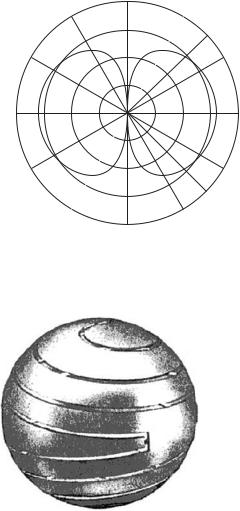
188 |
Design and practice of small antennas I |
|
|
30 |
010 |
30 |
dB |
||
|
0 |
|
60 |
–10 |
60 |
|
|
|
|
–20 |
|
90 |
|
90 |
120 |
|
120 |
150 |
|
150 |
|
180 |
|
Figure 7.156 θ -sweep radiation pattern of the four-arm folded spherical helix (dominant polarization is Eθ ) ([76], copyright C 2010 IEEE).
Figure 7.157 Two-arm folded spherical helix dipole ([76], copyright C 2010 IEEE).
in the number of arms, radiation resistance can be increased as shown in Table 7.19; however, with 16 slots self-resonance can be achieved. The slots are connected at the top and bottom of the sphere. The 4, 8, and 16-arm versions of the antenna are illustrated in Figure 7.158(a), (b), and (c), respectively. The performances are provided in Table 7.19, where the 16-arm version shows Q of 148.5, that is about three times the lower bound. Radiation pattern of the 16-arm version is shown in Figure 7.159, which indicates a dominant magnetic dipole or TE mode (Eϕ ) pattern, having omnidirectional pattern in the vertical plane.
Three other modified spherical magnetic dipoles are developed [78]. Antenna configurations are illustrated in Figure 7.160, where (a) multi-arm spherical helix (MSH),
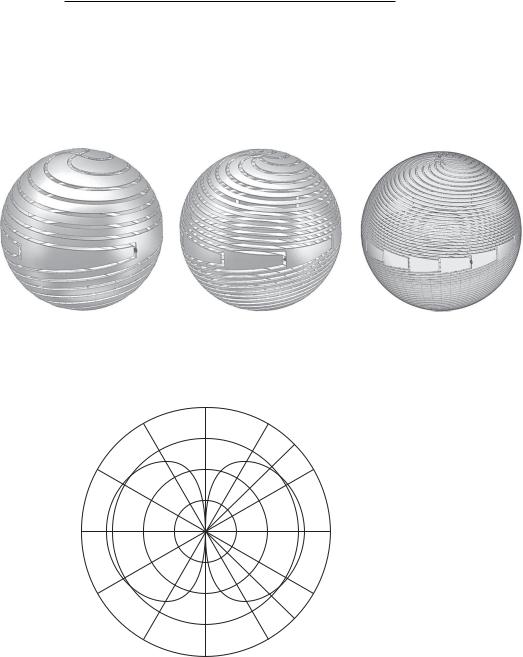
7.2 Design and practice of ESA |
189 |
|
|
Table 7.19 Comparison of performances for the 2, 4, 8, and 16-arm folded slot spherical antennas ([76], copyright C 2009 IEEE)
|
Frequency |
|
|
|
|
No. Arms |
(MHz) |
ka |
R( ) |
Q |
VSWR |
|
|
|
|
|
|
2 |
294.9 |
0.266 |
0.62 |
502.7 |
81.2 |
4 |
274 |
0.245 |
2.17 |
327.1 |
23 |
8 |
309.1 |
0.279 |
Not Resonant |
169.6 |
2.33 |
8 |
310.4 |
0.28 |
15.1 |
173.8 |
3.31 |
16 |
306.4 |
0.276 |
Not Resonant |
148.5 |
1.22 |
|
|
|
|
|
|
(a) |
(b) |
(c) |
Figure 7.158 (a) Four-arm folded spherical helix dipole, (b) eight-arm folded spherical helix dipole, and (c) 16-arm folded spherical helix dipole, ([76], copyright C 2010 IEEE).
30 |
010 |
30 |
dB |
||
|
0 |
|
60 |
–10 |
60 |
|
|
|
|
–20 |
|
90 |
|
90 |
120 |
|
120 |
150 |
|
150 |
|
180 |
|
Figure 7.159 θ -sweep radiation pattern of 16-arm folded spherical helix dipole (dominant polarization is Eϕ ) ([76], copyright C 2010 IEEE).
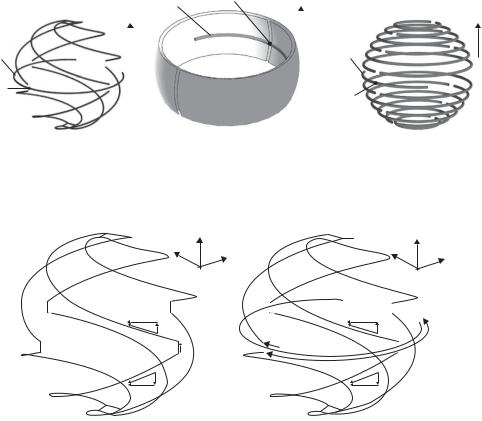
190 |
Design and practice of small antennas I |
|
|
|
|
Excitation |
Feed point |
||
|
|
dipole |
Z |
|
|
Z |
|
|
|
Z |
|
|
|
|
|
||
|
|||||
Excitation |
|
|
|
|
Excitation |
|
|
|
|
||
dipole |
|
|
|
|
dipole |
|
|||||
Feed point
Feed point
(a) |
(b) |
(c) |
Figure 7.160 Geometry of spherical magnetic dipole (TE10 mode) antenna: (a) multi-arm spherical helix (MSH) antenna, (b) spherical split-ring resonator (S-SRR) antenna and (c) spherical split ring (SRR) antenna, ([78], copyright C 2010 IEEE).
|
Y |
Z |
|
|
Z |
|
X |
|
Y |
X |
|
|
|
|
|
||
Iϕ |
|
|
|
Iϕ |
|
|
Iθ |
|
V |
Iθ |
|
I |
V |
|
I |
|
|
|
|
|
|
|
|
I |
|
|
α |
I |
|
|
Iθ |
|
|
Iθ |
|
Iϕ |
|
|
|
Iϕ |
|
(a) |
|
|
(b) |
|
|
Figure 7.161 Multi-arm spherical helix (MSH) antenna: (a) TM10 (electric mode) and (b) TE10 (magnetic mode) ([78], copyright C 2010 IEEE).
(b) spherical split ring resonator (S-SRR) antenna, and (c) spherical split ring (SSR) antenna are shown.
The TE10 MSH is a modification of a spherical helix developed by Best [72]. In the TM10 MSH antenna, the top and bottom of the arms are disconnected and a curved dipole is placed at the quarter of the antenna sphere as shown in Figure 7.161(a), where in (b) a TE10 spherical mode is also shown as a reference. The antenna is fed at the midpoint of the driven dipole by applying driving voltage horizontally so as to cancel the far-field contribution from the θ -component produced by the electric current (Iθ ), resulting in only fields of the desired TE10 spherical mode remaining. The antenna is tuned to the resonance by changing the number of turns (Nturns) in the arm for given frequency f0 and number of arms (Narms) as is shown in Figure 7.162, where input impedance at f0 = 300 MHz is plotted for antennas of Narms = 2, 4, 6, and 8. All antennas have radius of 40 mm, and the wire radius is set to 0.5mm. The antenna occupies a spherical volume

7.2 Design and practice of ESA |
191 |
|
|
Table 7.20 Characteristics of the TE10 MSH antenna ([78], copyright C 2010 IEEE)
Narms |
Nturns |
α,◦ |
Q |
QLB |
Q /QLB |
TE10,dB |
TM11,dB |
TM20,dB |
QLBHO |
Q/QLBHO |
2 |
2.39 |
163 |
249.6 |
64.6 |
3.87 |
−0.047 |
−22.4 |
−23.0 |
91.1 |
2.74 |
4 |
2.24 |
143 |
218.5 |
64.6 |
3.39 |
−0.030 |
−27.2 |
−23.0 |
90.6 |
24.1 |
6 |
2.19 |
140 |
210.7 |
64.6 |
3.27 |
−0.027 |
−29.5 |
−23.0 |
90.0 |
2.34 |
8 |
2.17 |
140 |
207.0 |
64.6 |
3.21 |
−0.026 |
−30.4 |
−23.0 |
90.0 |
2.30 |
Input impedance (kΩ)
5 |
Resistance |
|
|
|
|
2 arms |
|
4 |
Reactance |
|
|
6 arms |
4 arms |
||
|
|
|
|
3 |
8 arms |
|
|
2 |
|
|
|
1 |
|
|
|
|
|
|
|
|
0 |
|
|
|
|
|
|
|
|
−1 |
|
|
|
|
|
|
|
|
−2 |
|
|
|
|
|
|
|
|
−3 |
|
|
|
|
|
|
|
|
2.1 |
2.15 |
2.2 |
2.25 |
2.3 |
2.35 |
2.4 |
2.45 |
2.5 |
Number of turns
Figure 7.162 Input impedance of the TE10 MSH antenna as a function of number of turns in each arm ([78], copyright C 2010 IEEE).
of radius a = 40.5 mm, which corresponds to ka = 0.254 at 300 MHz. Table 7.20 summarizes the resonance state characteristics of the TE10 MSH antenna for different numbers of arms. Here QLB is the lower bound Q and QHOLB is QLB in the presence of higher modes.
The spherical split-ring resonator (S-SRR) antenna is composed of a spherical splitring resonator and a curved driven dipole arranged so as to produce mostly ϕ-directed electric surface currents, thus the desired TE10 mode. Since the antenna has symmetrical structure, it can be placed on the ground plane as Figure 7.163 illustrates. The S-SRR can be made electrically small, as the large area of the two spherical surfaces overlapped. The geometrical parameters are; r0 = a = 21 mm, t = 0.8 mm, g = 1 mm, rmnp = 18 mm, and the radius of the monopole = 0.5 mm. To achieve lower Q, the S-SRR should cover the whole sphere (β = π ); however, this results in blocking the magnetic flux over the antenna cross section and thus diminishes the electric current on the antenna surface. Therefore there is an optimum coverage to yield a minimum Q. It was found the angle β = 73◦ is the optimum to obtain smallest Q/QLB. The resonance frequency depends also on the coverage and it becomes lowest when β = 64◦, which differs from the optimal β for the smallest Q/QLB, although the difference

192 |
Design and practice of small antennas I |
|
|
t |
|
rmnp |
|
r0 |
|
Y |
|
α |
X |
β |
|
Z |
Feed point |
0.5 g
Figure 7.163 Spherical split-ring resonator (S-SRR) antenna on a ground plane ([78], copyrightC 2010 IEEE).
r0
α
y
z
2γ
Feed point |
|
0.5 g |
x |
|
|||
|
|
|
|
Figure 7.164 Spherical split ring (SSR) antenna on a ground plane ([78], copyright C 2010 IEEE).
in the resonance frequency is minor, being only 1.5 MHz. For β = 73◦, the resonance frequency f0 is 297.0 MHz and ka = 0.133. The input impedance can be adjusted by the length of the driven dipole, and with α = 55◦, the input resistance at the resonance R0 is 50 for the optimal β = 73◦. The lowest Q/Qlb obtained is around 3.4, which is nearly the same as that of MSH.
The spherical split ring (SSR) antenna consists of individual wire split rings distributed evenly in θ as shown in Figure 7.160(c). Every two neighbor rings are flipped with respect to each other and thus, operate as a conventional SRR. Multi-element SRR is constituted by combining rings with other rings so that uniform current distribution over the spherical surface is realized and the resonance frequency is lowered. The number of the rings is chosen to be odd, so that the antenna is driven at the central split ring, the length of which is adjusted to attain the input impedance to match the feed line. Since the SSR has symmetrical structure, it can be made in half and mounted on the ground plane as shown in Figure 7.164. The resonance frequency is changed by the number of split rings Nsr and is determined by using the following expression
Nsr = 2int(90◦/γ ) − 1 |
(7.68) |
